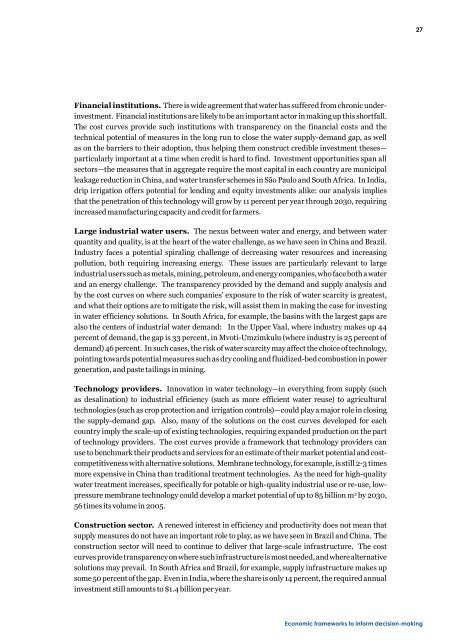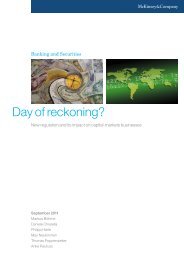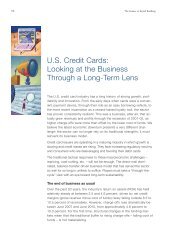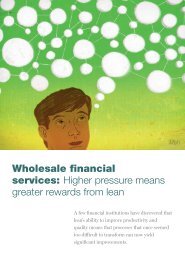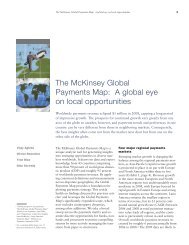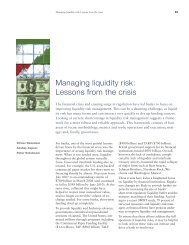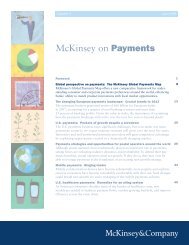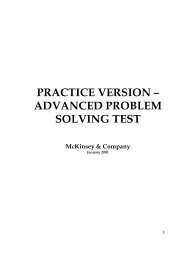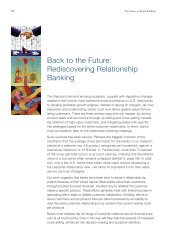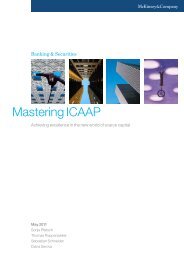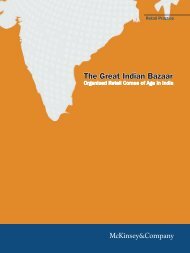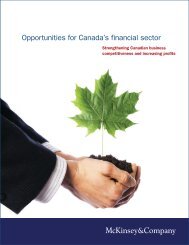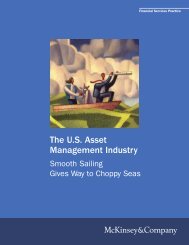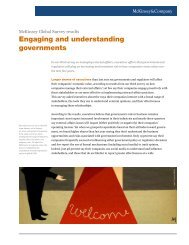Charting Our Water Future - McKinsey & Company
Charting Our Water Future - McKinsey & Company
Charting Our Water Future - McKinsey & Company
- No tags were found...
You also want an ePaper? Increase the reach of your titles
YUMPU automatically turns print PDFs into web optimized ePapers that Google loves.
27Financial institutions. There is wide agreement that water has suffered from chronic underinvestment.Financial institutions are likely to be an important actor in making up this shortfall.The cost curves provide such institutions with transparency on the financial costs and thetechnical potential of measures in the long run to close the water supply-demand gap, as wellas on the barriers to their adoption, thus helping them construct credible investment theses—particularly important at a time when credit is hard to find. Investment opportunities span allsectors—the measures that in aggregate require the most capital in each country are municipalleakage reduction in China, and water transfer schemes in São Paulo and South Africa. In India,drip irrigation offers potential for lending and equity investments alike: our analysis impliesthat the penetration of this technology will grow by 11 percent per year through 2030, requiringincreased manufacturing capacity and credit for farmers.Large industrial water users. The nexus between water and energy, and between waterquantity and quality, is at the heart of the water challenge, as we have seen in China and Brazil.Industry faces a potential spiraling challenge of decreasing water resources and increasingpollution, both requiring increasing energy. These issues are particularly relevant to largeindustrial users such as metals, mining, petroleum, and energy companies, who face both a waterand an energy challenge. The transparency provided by the demand and supply analysis andby the cost curves on where such companies’ exposure to the risk of water scarcity is greatest,and what their options are to mitigate the risk, will assist them in making the case for investingin water efficiency solutions. In South Africa, for example, the basins with the largest gaps arealso the centers of industrial water demand: In the Upper Vaal, where industry makes up 44percent of demand, the gap is 33 percent, in Mvoti-Umzimkulu (where industry is 25 percent ofdemand) 46 percent. In such cases, the risk of water scarcity may affect the choice of technology,pointing towards potential measures such as dry cooling and fluidized-bed combustion in powergeneration, and paste tailings in mining.Technology providers. Innovation in water technology—in everything from supply (suchas desalination) to industrial efficiency (such as more efficient water reuse) to agriculturaltechnologies (such as crop protection and irrigation controls)—could play a major role in closingthe supply-demand gap. Also, many of the solutions on the cost curves developed for eachcountry imply the scale-up of existing technologies, requiring expanded production on the partof technology providers. The cost curves provide a framework that technology providers canuse to benchmark their products and services for an estimate of their market potential and costcompetitivenesswith alternative solutions. Membrane technology, for example, is still 2-3 timesmore expensive in China than traditional treatment technologies. As the need for high-qualitywater treatment increases, specifically for potable or high-quality industrial use or re-use, lowpressuremembrane technology could develop a market potential of up to 85 billion m 3 by 2030,56 times its volume in 2005.Construction sector. A renewed interest in efficiency and productivity does not mean thatsupply measures do not have an important role to play, as we have seen in Brazil and China. Theconstruction sector will need to continue to deliver that large-scale infrastructure. The costcurves provide transparency on where such infrastructure is most needed, and where alternativesolutions may prevail. In South Africa and Brazil, for example, supply infrastructure makes upsome 50 percent of the gap. Even in India, where the share is only 14 percent, the required annualinvestment still amounts to $1.4 billion per year.Economic frameworks to inform decision-making


